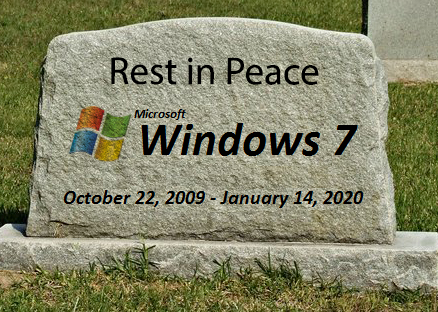Okay. We need to talk.
This is going to be hard for you to hear, but SOMEBODY has to tell you.
You HAVE to break up with Windows 7 (or ANY previous version of Windows)! And you have to do it by the end of this coming January! (2020)
I know. After disasters like Windows ME, Windows Vista, and Windows 8, you LOVE Windows 7. I do too. It had a good run. Best Windows operating system since Windows XP. You had a good thing.
But even good things come with an expiration date, and Windows 7’s is January 14th, 2020. As of that date, Windows will cease to support Windows 7 with patches and fixes.

Here’s what you need to know:
You have an important decision to make between now and January of 2020. Should you:
(A) upgrade the system you are currently using, or
(B) start saving up right now for a new system?
It really boils down to this: does your current system have enough horsepower to run Windows 10 well? Windows 10 requires MUCH more robust hardware resources than Windows 7, regardless of what Microsoft is telling you!
If you upgrade to Windows 10, or buy a Windows 10 system that is underpowered, you could be setting yourself up for a frustrating click-and-wait kind of computer experience.
When I use the term “horsepower,” I am talking about the combination of three hardware considerations:
- Is your processor (CPU OR APU) fast enough?
- Do you have enough RAM (memory)?
- Is your hard drive (the part where data is stored) fast enough and does it have a large enough capacity?
I urge you to ignore Microsoft’s so-called “minimum requirements” for Windows 10’s latest version. They make it sound like you can run this high-powered software on a typewriter.
(Some of you just went, “What’s a typewriter?”)
First of all, how can you find out what you’ve got? There is an easy way.
A free product called Belarc Advisor will tell you more about your computer than you could ever want to know, all in about 2 minutes. You can download the software and read instructions here: https://www.belarc.com/en/products_belarc_advisor
Here is what you really need in order to have enough horsepower to run Windows 10 well.
- Processor – You need an Intel Core 2 Quad, Core i3, Core i5, Core i7, or Core i9 processor, or comparable AMD processor.
If you have an Intel Pentium, Pentium Dual-Core, Core 2 Duo, Celeron, or a comparable AMD processor, you will NOT be able to run Windows 10 well. - RAM (memory) – Windows 7 ran great with 4 GB of RAM. Windows 10 will not.
Windows 10 requires 6 GB at the very least, and will run MUCH better with 8 or more.
The limitation here is how much RAM the motherboard will support. Some will not support more than 4 GB. More RAM equates to smoother performance and less wear and tear on other parts (like processor and hard drive). - Hard drive – Make sure you have room for all that you’re going to want to store. And faster is better! In a perfect world, you would want everybody to have a solid state drive (SSD) – at least for a boot drive. Enormously expensive at first, these ultra-fast drives have come WAY down in price. As of September, 2019, you can get 240 GB for about $32. Your drive will boot up in seconds instead of minutes.
Even if your current computer will squeak by and run Windows 10 okay, you may want to think about moving up to take advantage of newer, faster technology, which will get you further down the road. Just a thought.
So, here is the BIG question.
Why do I have to stop using Windows 7?
Is something terrible going to happen to me if I keep using it?
You’ll likely be okay for a few months. But eventually, virus and malware writers will discover new holes and leaks, and will be able to build software “bots” that can target those openings to secretly get into your computer. They can then use your computer to launch “exploits” against other computers, networks, or websites – for example, Denial-of-Service attacks. And you might never know that your computer is being controlled by someone else – except for running slow and grinding away. Or, they could simply find a way to cause harm to your system, and make it send the harmful code to someone else. When nobody is discovering and patching the vulnerabilities, YOU become more and more vulnerable.
Patching and updating is critically important. That’s why you should ALWAYS let Windows do its updates.
But isn’t Windows 10 difficult? I’ve heard that it has a HUGE learning curve.
So many people absolutely HATED the initial Windows 10 release, that Microsoft went back and made it more like Windows 7. There are still some of the “tiles” available, if you liked Windows 8 and the first Windows 10 release, but now you can also have shortcuts and links to programs on the Windows Desktop and the Launch Bar, just as with Windows 7. You can even make it almost EXACTLY like Windows 7 with a free product called Classic Start, which you can download from Ninite.com (it’s in the Utilities category). And finding settings is easy. Just click on the “Settings” button, or type the particular setting you need in the Search window. There is really not that much of a learning curve.
DO NOT – DO. NOT. automatically upgrade your computer to Windows 10, even if you can. If your computer’s specs are not up to speed, using your computer could become a massive source of frustration.
Is there any downside to moving to Windows 10?
Windows 10 is a solid, stable, slick operating system and a pleasure to use. But there is one thing…
Some stuff is probably going to break. Some of the programs you have loved using in previous versions are either not going to work in Windows 10, are not going to work reliably in Windows 10, or are going to work, but a bit differently. So there is that.
Is there anything you can do about that? Sometimes,
running older programs in Compatibility Mode will fix the problem. Here is an
article that tells you all about how to accomplish that:
https://www.groovypost.com/howto/run-old-software-windows-10-compatibility-mode/
But sometimes even Compatibility Mode won’t do the trick. The road to bigger/better/faster technology is often littered with the “roadkill” of great programs that got steamrolled by new operating systems. It can be heartbreaking, but it’s a fact of life.
Is anything missing in Windows 10 that was in Windows 7?
There are a few things, but two are particularly noticeable:
- The
Windows 7 games are gone.
If you miss them, and you are a little computer savvy, or have a friend who is, you can download and install the games from this link: https://winaero.com/download.php?view.1836 - Windows
10 does not include a way to play DVDs.
You need to install a free DVD player program called VLC to fix this problem. You can download and install it from https://ninite.com/. It’s in the Media category.
One more thing – do NOT assume that if you buy a new computer off the shelf or off the Internet, that it will have enough horsepower to run Windows 10. Stores and manufacturers routinely sell stripped down, underpowered systems, with every imaginable corner cut, so that they can make the price extra attractive. Time and time again I’m seeing my clients taken in by these “specials,” just because the price is so hard to pass up. DON’T YOU BE TAKEN IN! Take the time make sure the specifications of your potential purchase are sufficient.
Now is the time to start thinking about your options and plotting a Windows 10 strategy. With some planning, and perhaps, saving up, you won’t be making last-minute (and maybe not-so-good) choices you may regret.
I invite your comments and questions below. ______________________________________________________________________________
* Randy Moody has 25 years’ experience building, repairing, refurbishing, upgrading, and networking PC desktop and laptop computers. Articles like this one are offered in the hope that they can save you time, money, and frustration.




Hi Randy,
I am in this category. Thanks for the info.
Thanks for taking the time to read it, Doug.
☹️…i’m Not dumb, but sometimes I really struggle with technology. So, sounds like I need a new computer.; can I transfer files/photos from my old computer to my new? I have software purchased year ago for Microsoft Office (word, excel, PowerPoint)…am I going to have to repurchase for Windows10? Since I have to upgrade, should I make the move to Mac?
Hi, Barbie — Thanks for reading my post! You (or a savvy friend) should be able to transfer all your data from the old computer to the new. You can still use your MS Office. Run Belarc Advisor on your old computer (it’s mentioned in the article). One thing you’ll get from that is the installation key for your MS Office. If you still have the installation DVD, just use that to reinstall on your new system. If not, you can Google where to download the various versions of Office (you need to get the exact edition that you have – Belarc will tell you that) – then install it and use that installation key. You’ll have to do that for all your programs. But that’s what I love about Belarc. It gives you all the keys.
Move to Mac? Why would anybody want to do that? Only if you want to pay twice as much for everything you use on it. And only if you love the interface. Not I. Mac and I just don’t click. Great questions! Good luck!
Well yes I procrastinated until now. I have the Pentium processor so based on your article, things will move slowly. Do you have recommendations for new laptops?
Hi, Jim — thanks for reading my post. First, what NOT to get. A lot of people are falling for Netbooks that aren’t being sold as Netbooks. If you see a wonderful deal on a laptop computer for two hundred dollars, it is likely a Netbook — a laptop made for use on the Internet only. It has NO storage space (hard drive) and can’t be upgraded. I recommend a Dell or HP computer with an Intel Core i3 or i5 processor, 8 GB or more of RAM, and a good-size hard drive (1 TB or more). If you watch the ads, you can sometimes find a really good deal on one. Good luck! PS — Things won’t move “slowly” on a Pentium class machine — they won’t move at all! –Randy